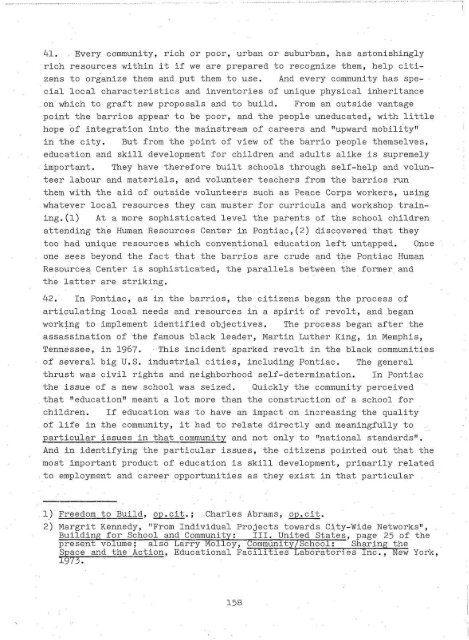BUILDING FOR SCHOOL AND COMMUNITY - Kennedy Bibliothek
BUILDING FOR SCHOOL AND COMMUNITY - Kennedy Bibliothek
BUILDING FOR SCHOOL AND COMMUNITY - Kennedy Bibliothek
Create successful ePaper yourself
Turn your PDF publications into a flip-book with our unique Google optimized e-Paper software.
41. . Every community, rich or poor, urban or suburban, has astonishingly<br />
rich resources within it if we are prepared to recognize them, help citizens<br />
to organize them and put them to use. And every community has special<br />
local characteristics and inventories of unique physical inheritance<br />
on which to graft new proposals and to build. From an outside vantage<br />
point the barrios appear to be poor, and the people uneducated, with little<br />
hope of integration into the mainstream of careers and "upward mobility"<br />
in the city. But from the point of view of the barrio people themselves,<br />
education and skill development for children and adults alike is supremely<br />
important. They have therefore built schools through self-help and volunteer<br />
labour and materials, and volunteer teachers from the barrios run<br />
them with the aid of outside volunteers such as Peace Corps workers, using<br />
whatever local resources they can muster for curricula and workshop training,<br />
(l) At a more sophisticated level the parents of the school children<br />
attending the Human Resources Center in Pontiac,(2) discovered that they<br />
too had unique resources which conventional education left untapped. Once<br />
one sees beyond the fact that the barrios are crude and the Pontiac Human<br />
Resources Center is sophisticated, the parallels between the former and<br />
the latter are striking.<br />
42. In Pontiac, as in the barrios, the citizens began the process of<br />
articulating local needs and resources in a spirit of revolt, and began<br />
working to implement identified objectives. The process began after the<br />
assassination of the famous black leader, Martin Luther King, in Memphis,<br />
Tennessee, in 1967. This incident sparked revolt in the black communities<br />
of several big U.S. industrial cities, including Pontiac. The general<br />
thrust was civil rights and neighborhood self-determination. In Pontiac<br />
the issue of a new school was seized. Quickly the community perceived<br />
that "education" meant a lot more than the construction of a school for<br />
children. If. education was to have an impact on increasing the quality<br />
of life in the community, it had to relate directly and meaningfully to<br />
particular issues in that community and not only to "national standards".<br />
And in identifying the particular issues, the citizens pointed out that the<br />
most important product of education is skill development, primarily related<br />
to employment and career opportunities as they exist in that particular<br />
1) Freedom to Build, op.cit.; Charles Abrams, op.cit.<br />
2) Margrit <strong>Kennedy</strong>, "From Individual Projects towards City-Wide Networks"<br />
Building for School and Community: III. United States, page 25 of the<br />
><br />
present volume; also Larry Molloy, Community/School: Sharing the<br />
Space and the Action, Educational Facilities Laboratories Inc., New York,<br />
1973.<br />
158
















